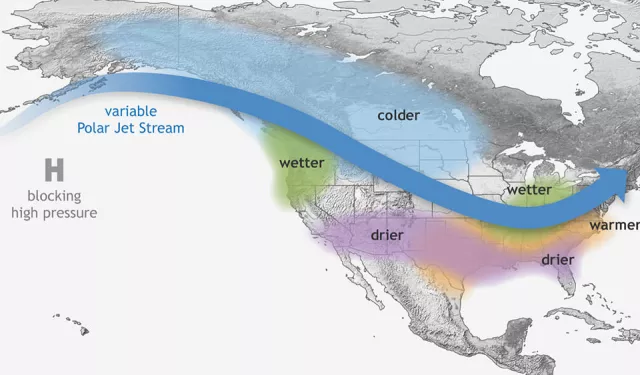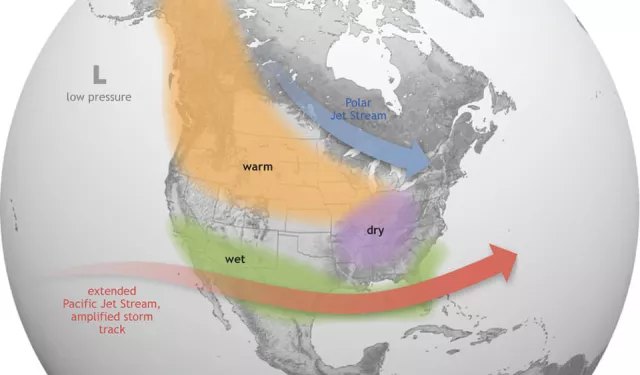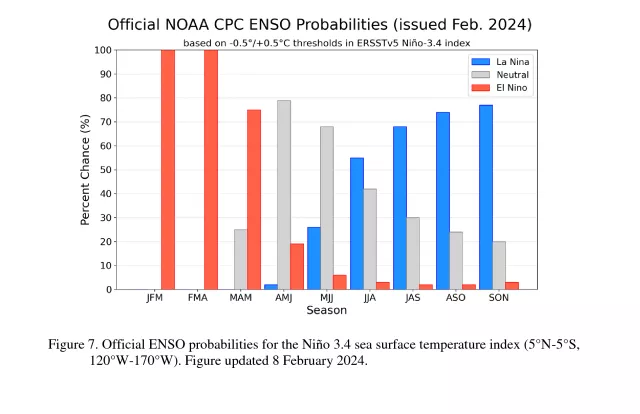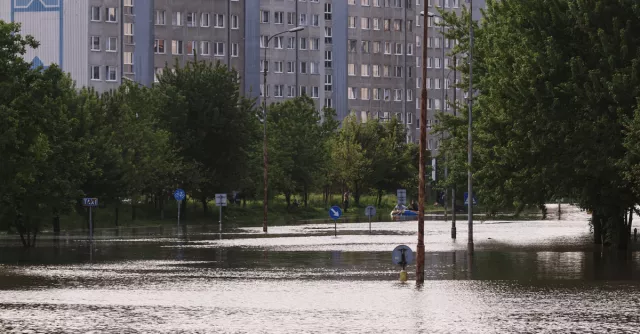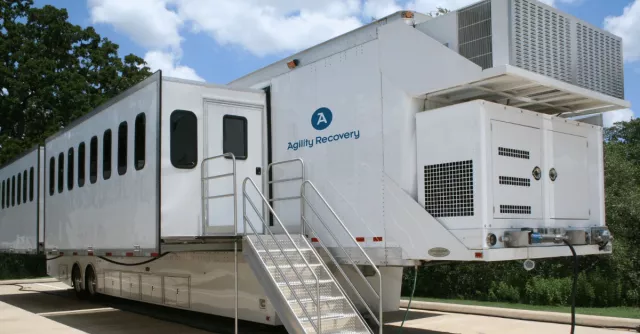El Niño and La Niña: What Businesses Need to Know
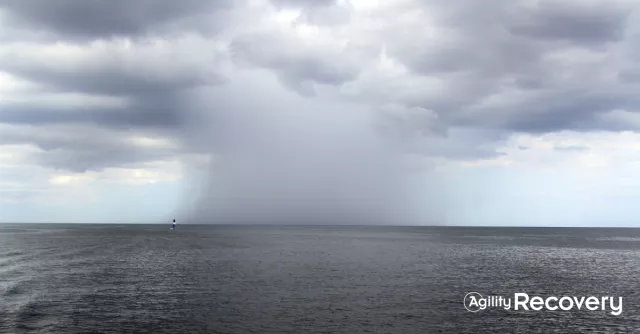
El Niño and La Niña are two opposing climate patterns that can cause extreme weather events, such as droughts, floods, and wildfires. These events can disrupt supply chains, damage infrastructure, and lead to power outages. In this blog post, we will explore what El Niño and La Niña are, how they impact weather, and how your business can prepare for them.
What is La Niña?
Every few years, the world experiences a climate phenomenon called La Niña, which significantly impacts weather patterns worldwide, often bringing cooler and wetter conditions compared to normal. This cooling effect is caused by changes in ocean temperatures in the Pacific, particularly the central and eastern tropical Pacific Ocean, where the waters become colder than usual. These cooler temperatures alter wind patterns, resulting in shifts in precipitation and storm tracks.
During a La Niña event, the cold ocean temperatures in the central and eastern tropical Pacific intensify the trade winds, which blow from east to west across the Pacific Ocean. These stronger trade winds push more warm water from the western Pacific to the eastern Indian Ocean and western Pacific, further cooling the central and eastern tropical Pacific Ocean. This cooling effect on the ocean surface changes atmospheric circulation patterns, resulting in altered temperature and precipitation patterns worldwide.
La Niña events typically last for 9 to 12 months but can sometimes persist for as long as 18 months. They occur irregularly and can be followed by a neutral phase or an El Niño event, which is characterized by warmer-than-average sea surface temperatures in the central and eastern Pacific Ocean.
What is El Niño?
El Niño is a climate phenomenon that occurs in the Pacific Ocean. It is characterized by unusually warm ocean temperatures in the central and eastern tropical Pacific Ocean. Like La Niña, El Niño events typically last for 9 to 12 months, but they can sometimes last for as long as 18 months.
The warm ocean temperatures associated with El Niño can have a significant impact on weather patterns around the world. For example, El Niño events can lead to increased rainfall in some areas and drought in others. They can also cause changes in sea level, which can lead to coastal erosion and flooding.
El Niño events occur every 3 to 7 years, but they are not always of the same intensity. Some El Niño events are very strong, while others are relatively weak. The strength of an El Niño event is determined by the amount of warm water in the central and eastern tropical Pacific Ocean.
El Niño events can have a significant impact on businesses. For example, El Niño events can lead to crop failures, which can drive up food prices. They can also lead to disruptions in shipping and transportation, which can increase the cost of doing business.
Businesses need to be aware of the potential impacts of El Niño events so that they can take steps to mitigate the risks. For example, businesses can diversify their supply chains so that they are not reliant on a single source of raw materials. They can also purchase insurance to protect themselves against losses caused by El Niño events.
How Do La Niña and El Niño Impact the Weather?
El Niño and La Niña can significantly impact weather patterns worldwide. During El Niño, the central and eastern Pacific Ocean experiences unusually warm temperatures, leading to changes in atmospheric circulation patterns. These changes can cause increased rainfall in some parts of the world, such as the west coast of North America and Peru. Conversely, other areas, like Australia and Southeast Asia, may experience droughts.
In contrast, La Niña is characterized by unusually cool ocean temperatures in the central and eastern Pacific Ocean. This cooling leads to changes in wind patterns, resulting in increased rainfall in Australia, Indonesia, and the Philippines. On the other hand, the southern and eastern regions of South America and the southern coast of Africa may experience droughts.
2024 Predictions and Threats
Predictions for El Niño and La Niña in 2024 remain uncertain due to the complex and dynamic nature of these climate phenomena. However, scientists continue to monitor various indicators such as sea surface temperatures, atmospheric pressure patterns, and oceanic circulation to forecast their development.
A USA Today article discussed the recent declaration of a "Super El Niño" event and the impending arrival of La Niña conditions. The "Super El Niño" event, characterized by unusually warm sea surface temperatures in the equatorial Pacific Ocean, is expected to influence weather conditions worldwide, including increased rainfall in some regions and droughts in others. Meanwhile, an emergence of La Niña conditions could bring about contrasting weather patterns, such as cooler sea surface temperatures and potential shifts in precipitation distribution.
Some climate models suggest a neutral ENSO (El Niño-Southern Oscillation) state for 2024, indicating near-average sea surface temperatures in the equatorial Pacific Ocean. This scenario would likely result in relatively normal weather patterns across affected regions, with neither El Niño nor La Niña exerting significant influence.
However, it's essential to note that ENSO predictions can vary, and shifts in oceanic and atmospheric conditions could lead to unexpected changes in the forecast. Therefore, ongoing monitoring and analysis by meteorologists and climatologists is crucial to providing accurate predictions and informing communities and policymakers about potential impacts on weather patterns, agriculture, and ecosystems.
Although there is uncertainty associated with seasonal climate predictions, businesses can use historical data, expert analysis, and ongoing monitoring to make informed decisions and adapt to changing conditions.
How Businesses Can Prepare for La Niña and El Niño
To mitigate the potential risks associated with La Niña and El Niño events, businesses should implement comprehensive preparedness plans that encompass various strategies.
Supply Chain
One crucial step is to revisit and revise supply chain management strategies to ensure resilience in the face of climate-induced disruptions. This includes diversifying suppliers and sourcing locations, establishing safety stock levels, and enhancing communication with suppliers to ensure timely response to changing conditions. When your organization tests its business continuity plan, be sure to include third-party suppliers.
Backup Fuel and Power
During any type of severe weather, businesses should be prepared for potential power outages and fuel shortages. Even if your organization stores backup generators and fuel on site, it is important to also have a backup for your backup. Agility Recovery provides power, fuel, testing, electrical connection support, and more with assured access and delivery to help businesses maintain resilience.
Risk Assessments
Protecting assets and infrastructure is paramount to minimizing the financial impact of climate-related events. Businesses should conduct risk assessments to identify vulnerable assets and implement measures to safeguard them, such as reinforcing buildings against extreme weather conditions, installing flood protection systems, and regularly maintaining equipment to ensure its reliability.
Business Continuity Testing
Without testing your organization's plan, you won't know whether it will actually work in case of a disaster. Business continuity plan testing is a key part of risk assessments and compliance requirements, and we encourage organizations to test twice a year at the least. Agility can assist with your testing, whether a tabletop test, onsite test, or plan assessment.
Inventory Management
Proactive inventory management is another key element of preparation. Businesses should optimize their inventory levels to minimize the impact of potential supply chain disruptions. This can be achieved through accurate demand forecasting, implementing just-in-time inventory systems, and maintaining strategic stockpiles of essential goods.
Stay Informed
Furthermore, staying informed about weather forecasts and climate predictions is essential for businesses to anticipate and respond to La Niña and El Niño events effectively. Regularly monitoring weather updates and subscribing to weather alerts can help businesses make informed decisions regarding operations, logistics, and resource allocation.
Conclusion
Despite the uncertainties associated with seasonal climate predictions, businesses can enhance their resilience to La Niña and El Niño by adopting proactive measures, informed decision-making, and ongoing monitoring of climate developments. Agility can help with your planning, preparation, and even backup power. Reach out to us today.
